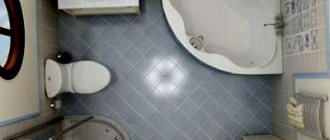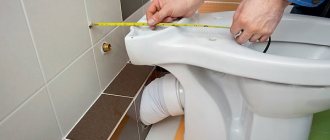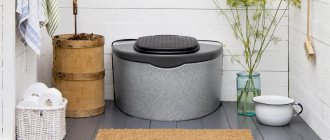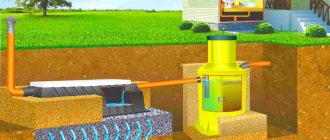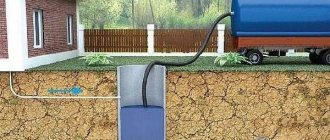Types of toilets for a private home with and without sewerage
If sewerage is not planned, you can purchase a bio-or electric toilet. Modern technologies make it possible to create a classic bathroom with running water, a toilet and waste disposal in any private house - brick, wood, frame.
If there is no possibility of connecting a central sewerage system to a suburban area, the construction of a drainage tank - a cesspool or a septic tank - will be required. If you do not place the toilet in a country house with internal and external sewerage, the amenities can be located in a separate room. A toilet or seat is installed there with an outlet into the drainage pit. Or select a device without a cesspool:
- chemical dry toilet;
- compost septic tank;
- electric toilet;
- powder-closet.
For such a system to function, no water supply is required: installing a small washbasin for hygiene procedures is quite enough.
Installing a toilet for a toilet
In most private homes, the floors are made of wood. Therefore, the work of installing a toilet bowl for a toilet begins with preparation: it is strengthened, leveled, and then linoleum is laid. If the pipe neck is located above the toilet outlet, then in this case you will have to think about raising it.
To create a podium, you can use a wide board and several pieces of timber as the main materials. When a podium is created on a concrete floor , the main materials for the work are brick and cement. When using wood, you need to cover it with drying oil and paint it. In this case, the structure will serve for a long time.
In most cases, when creating a sewerage system in a private house, its connection can be made directly: a regular cuff with an o-ring is inserted into the pipe, and the toilet outlet is installed into it. If this is not possible, then you should use a corrugated cuff or use a plastic eccentric. It is easier to connect to a local pump, since its inlet is located at a standard height. Everything necessary for docking is already available.
When the toilet is installed in its intended place, it is necessary to check the reliability of its connection to the sewer. After this, you should mark the holes . Next you need to remove it, and then drill the floor. The mounting kit usually comes with the plumbing product. It includes self-tapping screws, and in addition plastic dowels, washers with decorative caps.
Next, you need to install the toilet in place, using a level, and check the evenness of the entire location. If this is necessary, then it is worth leveling the product by placing some solid object under the base. When the work is completed, it is necessary to seal the resulting gap with cement. In the event that the installation is carried out on a podium, then the alignment is carried out already at the stage of creating the structure.
Then you can secure the toilet using self-tapping screws. During this work, you must remember to place soft washers under the caps. Be sure to syringe the connection between the pipe and the cuff using silicone sealant. The same must be done with the base of the toilet to prevent water from flowing under it. Now all that remains is to connect the water to the drain tank. To do this, use a coaxial hose , in front of which a tap is usually installed.
Gravity sewer system
In the case when the slope is less than permissible, the speed of the flow slows down and this point is a big drawback (read: “What is the optimal slope of a sewer pipe”). It is necessary to ensure such a ratio between the filling of the pipe and the speed of sewage movement so that self-cleaning occurs during its operation. Otherwise, a coating will appear on the inner surface of the pipeline, preventing drainage and contributing to the formation of blockages.
Working inside a toilet and releasing sewer pipes
To make a toilet in a private house
with a concrete floor, it will be necessary to open part of the screed. To do this, you can use a hammer drill or a hammer. Depending on the height of the floor relative to the ground level, you need to go 30-40 centimeters deeper. First, we determine the exact future location of the toilet - it is chosen arbitrarily, based on the parameters of the room and sound logic. Then we open a trench the width of the pipe from the place where the pipe will come out of the floor to the place where it will go in the direction of the drainage pit or septic tank. Using a hammer drill, we make a hole in the wall at this level slightly larger than the width of the pipe.
After installing the drain pipe (diameter 100-120) and installing the corner joint, releasing it in the toilet upwards just above floor level, fill the remaining space with concrete and let it set. Do not forget about the slope, so it is better to do the filling after the installation and connection of the entire sewer pipe with the septic tank is completed. The trench in which the pipe was laid is filled with earth. If you use steel pipes, then you do not need to further strengthen them. But the plastic pipe is afraid of soil subsidence, so it is necessary to strengthen it. It is fashionable to use a steel case, but this is not economical.
Another way out is to pre-fill the screed at the bottom of the trench, strengthening it with steel reinforcement. You can also pour small sides under the formwork, slightly higher in height than the thickness of the pipe. The result is a concrete case, which is covered on top with a tarred board or strips of steel 3-4 mm thick. Everything is covered with earth on top and lightly compacted. This way the pipe will be under reliable protection.
If there is a central water supply system, then you just need to run a pipe or flexible hose into the toilet, install a shut-off valve and connect it to the tank. But if there is no such system, then the solution would be to install a 200-liter tank in the technical room above the toilet. In the lower part of this container (plastic is perfect) a small hole is made for mounting a faucet or flexible hose directly. Ideally, you can use a double-sided adapter, one part of which is attached to the barrel in the hole made with two nuts through rubber gaskets, and the second is left free for screwing on the hose.
The second part of the hose is connected to the tank. You can replenish the container using a conventional vibration pump “Springhead”, and the frequency of replenishment will depend on the intensity of use of the toilet. On average, one drain, depending on the type of barrel, takes about seven to eight liters of water. That is, a 200 liter container is enough for about 25 flushes.
Features of arranging a toilet in the country
Such an important aspect as the arrangement of a country toilet has a mandatory regulatory framework. Including an article in the code of administrative violations, according to which the discharge of fresh sewage into compost or a well without a bottom is regarded as a fact of “damage to the earth” (the same as the use of a leaky cesspool).
According to the standards, there are three ways to collect, neutralize and remove sewage at the dacha:
- local (local) treatment facilities;
- using cesspool devices;
- non-sewered methods followed by composting.
We have already decided that building a toilet in a country house in a “classical” outhouse form is not practiced in a modern country house. As a result, all attention should be paid to arranging a more civilized and modern organization of the “latrine”.
We invite you to familiarize yourself with Hard Verbena
Choosing a suitable site for building a toilet
To prevent groundwater from spreading sewage, you must follow some rules:
- 25 meters is the minimum distance at which a latrine should be located from any source of water;
- from the cellar to the toilet should be more than 12 m, and to the bathhouse - 8 m;
- the distance by which the street closet should be removed from outbuildings is 4 m;
- An important technical condition when building a toilet is the groundwater level.
The main requirement is to correctly draw up a plan for the facility being built and comply with all sanitary standards.
Criterias of choice
Scheme of a three-chamber septic tank
Which of the two options is preferred is determined depending on the availability of the water supply network. If there is a water supply system, or it is planned to have one, a scheme with a toilet and sewer drain is designed. For a small summer house with seasonal residence, it will be enough to install an outdoor toilet.
It is also necessary to choose the option of an autonomous sewer system, if it is planned. A simple solution is to build a cesspool - a tank without a bottom with walls made of bricks, concrete rings or even old car wheels. Sewage accumulates in it for a certain time, after which it is pumped out using sewage disposal equipment.
A cesspool is suitable for seasonal stays at the dacha: the number of pumpings depends on the volume of wastewater and is quite expensive if a large family lives permanently.
You can also install an inexpensive sealed septic tank, which will also have to be pumped out regularly, or an effective, but expensive treatment plant. You can choose a compromise - make a two-chamber overflow septic tank. It consists of two separate wells: one is sealed and equipped with a bottom, the second is without a bottom, but with a filter pad.
Bathroom layout: what's what
Often, homeowners begin to plan the placement of plumbing fixtures in the bathroom after the house with all the plumbing facilities has already been built, and serious problems begin: “the stone flower does not grow together.”
Here is an example from our participant with the nickname Mishelka1973: she needs to install a bathtub, sink and toilet in her bathroom. The sewer outlet is marked on the diagram with a blue dot.
If you move the sink, a regular 170 cm long bathtub will fit, but the best solution would be a small asymmetrical bathtub.
A corner bathtub is preferable for small bathrooms; it provides incredible space compared to a traditional 170*70 cm bathtub.
The photo below shows a simple corner bath measuring 135x135 cm from a member of our portal with the nickname Starajamisch66.
Starajamisch66 Member of FORUMHOUSE
If you are not two meters tall, do not think that you will not fit.
Here are two more photos of this bathtub from different angles. Hatches in the podium provide access to communications and various useful items stored in it.
According to the experience of our participants, it is better not to buy a side panel for the bathtub, but to tile the box.
When planning your own bathroom, it is recommended to proceed in the following order:
- Draw up a diagram of the premises, indicating the water supply outlet and sewerage drain;
- Make a list of necessary plumbing fixtures and furniture (in descending order of importance). Calculate their sizes.
- “Arrange” objects on the diagram. Ask your FORUMHOUSE colleagues to criticize your project.
Popular solutions
The disadvantage of a separate cabin, which is called “yard amenities”, is the seasonality of use. That is, you can use it in warm weather, but not when it gets cold. And what to do in those cases when in late autumn and winter the dacha is used as a place for a country weekend getaway - fishing, barbecue, etc.?
- autonomous “winter” sewerage plus water supply;
- backlash-closet;
- dry closet
This type of “country toilet” has the same layout as that of a permanent residence in a country house. And to reduce the load on treatment facilities, it is recommended to separate wastewater into “gray” and “black”.
How to remove the smell?
The nasty stench from the street toilet frightens the owners of summer cottages most of all. They understand very well that it is difficult to cope with it. To do this, you should take into account several available options that have long turned into interesting methods. What is it about?
- Proper ventilation;
- Peat;
- Chemicals.
Creating a ventilation system is a prerequisite, but in some cases even it cannot cope with the spread of odors. If it is not possible to urgently order the services of vacuum cleaners, you can use peat. Its addition will allow you to process sewage into fertilizer, which will be absorbed into the soil.
If we talk about daily care, we need to note the available chemicals. They help break down sewage into its constituent components, processing them in a unique way. This approach guarantees simplicity, but such expenses rarely suit people. The cost of the compositions is significant, so it is often more profitable to do without them.
A comfortable and beautiful toilet in the country is not a luxury. You can do it yourself, using proven rules and applying a little imagination. After which the surrounding landscape is complemented by an elegant house, surprising in its simplicity and brightness.
On this page there are two different versions of articles on how to make a toilet in a private house. Please read and choose what suits you best.
See pictures and videos of septic tanks at the end of the article.
Question: how to make a toilet in a private house
, has two solutions. Either the toilet is located inside the house, or outside it, on a personal plot. But in both cases, the construction of a cesspool is provided.
The most common form of toilet in a private house is a backlash closet, which is a modernized version of a regular village toilet. It can be placed both inside and in the yard.
1. Ventilation; 2. Cesspool
The best option for installing a cesspool is ready-made concrete rings, but in the absence of them, it is easy to make a cesspool for a toilet with your own hands.
To do this, a hole with a depth of 1.5 to 2 meters is dug in a remote part of the site. For ease of cleaning, the bottom of the pit is made with a slight slope. The inside of the pit is lined with brick or concrete, and the bottom is also concreted. Then the inner surface of the pit is plastered to prevent sewage from seeping into the soil. The cesspool cover is made double: the lower one is made of wood, the upper one is made of metal. The space between the lids is filled with mineral wool or bulk material (sawdust or peat). The sewer pipe is laid at a slight slope towards the cesspool.
A backlash closet differs from a regular toilet in the presence of constant ventilation of the cesspool. Asbestos-cement and ceramic pipes are used for ventilation installation. An exhaust pipe with a diameter of 100 - 150 mm is connected to a special backlash channel next to the chimney of a stove or stove that runs on solid fuel. If the house has gas heating, then the backlash channel is heated by a special tubular electric heater with a power of 25 to 40 W installed inside the channel. An important condition for high-quality operation of cesspool ventilation is the tightness of the backlash channel pipe connections.
Pressure system
In some cases, installing a toilet with gravity sewerage is problematic. Laying pipes with a diameter of about 100 millimeters through partitions and walls is quite difficult. Problems can be avoided if you install a pressure sewer system, the main element of which is a fecal pump (read: “Pressure sewer system - what is it, examples of devices”).
The use of this device leads to the fact that waste waste can move from bottom to top, despite the fact that the cross-section of the pipes is reduced significantly. Fecal pumps designed for domestic needs are distinguished by their compact size, aesthetic appearance, and the ability to pump liquid several meters in the vertical direction and tens of meters horizontally. Toilets with a built-in pump are available for sale.
How to build a toilet
In order to properly build a toilet, it is worth considering three important factors.
Firstly, it is necessary to take into account the proximity of the future toilet to sources of drinking water (boreholes, wells), since wastewater from the toilet, if it enters the soil, can pollute groundwater. It is best to place the toilet at a distance of 25-30 meters from water sources.
Secondly, it is necessary to take into account the constant direction of the wind so that during future use the smell from the toilet does not spoil the air in the surrounding area.
Thirdly, cesspools should not poison the soil and groundwater. To do this, the cesspool must be carefully insulated to prevent waste from leaking into the soil.
The simplest option for building a toilet is the so-called “Powder-closet”. It is a familiar booth, made of boards and mounted on concrete blocks or wooden beams. Instead of a cesspool, a certain container is installed, the contents of which are disposed of after filling. This option allows you to avoid the need to clean the cesspool, and therefore you will not have to resolve the issue of organizing the access of a sewer truck that removes waste from the cesspool.
Required tools and materials
For the sewer option, gray pipes for internal work with a cross-section of 50 mm, orange for external work with a cross-section of 110 mm and connecting fittings are required.
To build outdoor amenities you will need:
- beams for the frame base;
- sheet plywood;
- batten;
- roofing;
- door block.
We suggest you familiarize yourself with How to make a table from rounded logs. Making a table from logs with your own hands
Septic tanks
1. underwater pipe; 2. floating layer; 3. sapropel; 4. dividing partitions; 5. slotted holes; 6. outlet pipe.
- 1. underwater pipe;
- 2. floating layer;
- 3. sapropel;
- 4. dividing partitions;
- 5. slotted holes;
- 6. outlet pipe.
1. underwater pipe; 2. dividing partitions; 3. outlet pipe
- 1. underwater pipe;
- 2. dividing partitions;
- 3. outlet pipe
A couple of videos on the topic of toilets in the house
How are sewer pipes organized in a house: How are septic tanks made:
In our article we will talk about how to make a toilet in a private house with your own hands, choose a place, design, install pipes, and install a toilet.
A private country house is, perhaps, the cherished dream of any city dweller, which is why many have dachas, and some manage to allocate the required amount of money to purchase or build a full-fledged cottage. To ensure the most comfortable stay in the house at any time of the year and in any weather, an indoor toilet is necessary. If we are talking about construction from scratch, then in this case latrines are provided at the design stage, but how
, in which it has never been, is a serious issue that requires thoughtful solutions.
Installation of a warm toilet in the house
Bathroom in a wooden private house
First of all, you need to choose where the amenities will be located. You can save space in a two-story building by placing the bathroom under the stairs.
A toilet is installed in a wooden house with a sewerage system according to the same principle as in a building made of other materials:
- A ditch is dug from the building to the reservoir with a minimum depth of 0.7 m and a slope of approximately 2.5–3 cm per meter.
- A sand cushion is laid under the pipeline in a layer of 10–15 cm.
- Red pipes are laid and insulated, and joints are sealed. The ditch is subsequently filled up.
- The outlet of the line is connected to the storage tank.
- The pipeline is introduced into the house through a hole in the foundation and connected to the in-house riser.
- In the room itself, the toilet is first fixed. Its drain is connected to the pipe outlet coming out of the floor or wall using a rubber cuff and sealed with silicone.
- A tank is installed on the toilet, and a flexible line is connected to it, which will supply water from the water supply network.
Design and arrangement of a bathroom in a wooden mansion
When thinking about the design of a bathroom in a country wooden house, you should give preference to the country style, Provence. They perfectly emphasize the natural texture of wood and preserve its special energy.
It is better to decide in advance on the location of the necessary plumbing fixtures, furniture, and washing machine in the bathroom, even at the stage of drawing up the design project. This will help you select plumbing and household appliances of the required sizes and compactly place them in the room.
An example of how to decorate a bathroom in a frame house
Our selection of photos will clearly demonstrate interesting bathroom designs for private homes.
How to make a sewer outside
The design of the toilet involves laying the outer part of the sewer in a trench, the depth of which depends on the climate in the region. In this case, different pipes are used - from asbestos, cement, cast iron, plastic and ceramics. The most popular are plastic products.
For installation in trenches, only special plastic pipes are used; they are usually painted orange. In places where there is an increased load on the soil or sewerage is laid at great depths, preference should be given to products made from more durable materials or corrugated pipes (pro
Pit toilet
You can build a similar structure yourself. To make a toilet in a private house without sewerage, you must first dig a deep hole. During operation, waste will accumulate in it, the disposal of which occurs through evaporation and absorption into the soil. To completely clean a cesspool, you can resort to the services of sewer trucks, the frequency of which depends on the technological quality of the design and the depth of the pit.
How to make a toilet in a private house? First you need to select the material from which the above-ground part of the structure will be made. It could be:
- board;
- metal profile;
- brick, cinder block, foam block, etc.;
- slate sheets.
A reliable frame base and an effective ventilation system are important components of a quality toilet.
What to choose in the end?
Despite the abundance of country toilet projects on the Internet with drawings of cabins for every taste, it is better to buy a ready-made one - the difference in money is small, especially considering the wholesale and retail prices for building materials. And if there is no model that matches your desires or landscape design, then there is also a custom-made service.
Read later
We will send the material by email
Author of the article
Design engineer, editor of his own construction blog
Kirill Gromov
Where to make a bathroom
The placement of a bathroom largely depends on whether it will have a window. If not, then it can be placed near the northern wall of the house. If you want a window, especially a large one, then you need to choose a different location (ideally, the bathroom windows face east).
In a bathroom without a window there must be forced ventilation
A small window is also acceptable in the restroom, but then the window sill must be at least 130 cm from the floor in order to place a toilet or cabinet under it.
Construction device
Plastic sewerage is easy to assemble, as if it were a children's construction set. Installation begins from the lowest point, for which the next element is inserted into the socket of the previous part, but before that, sealant for plastic pipes, which is intended for such work, is applied to the end of the fitting or pipe.
This is necessary both to prevent leaks and to facilitate installation work. The fact is that with such a diameter of pipes, joining is not easy - it requires considerable effort. When the ends of the element are lubricated, the work happens much faster. When installing sewerage, you should avoid using right-angle bends, and a 90° turn can be performed using two 45° bends and thereby reduce the inhibition of fluid flows. If you need to shorten a long section of pipe, use a hacksaw. To secure the structure, use clamps on studs or clips (the latter products look more presentable). Before each turn, at the bottom of the risers and at the point where the sewer exits outside the house, inspections should be installed. If there is a need to combine a new plastic pipe with an old cast iron product, the connection is sealed using a special rubber cuff.
If there is a basement or room under the toilet for which the interior is important, then a horizontal section of the pipe can be placed in them under the surface of the ceiling.
This solution has obvious advantages:
- there is no need to go around corners, since the pipes will be laid along the shortest route, and this will save materials and time, and therefore money;
- sewer pipes will not take up space at the bottom of the room.
The elements that make up the pressure sewer are connected together by welding or using flanges. Depending on the characteristics of the fecal pump, the diameter of the pipes can vary between 20-40 millimeters. Laying can be done both from the outside and under the floor or in a wall groove.
How to build with your own hands?
How to build a toilet? First you will have to study a step-by-step guide with some tips. They will help simplify the task so that construction takes less time and also gives a reliable result. Yes, the sizes can be changed according to your own wishes, but the main nuances remain constant:
- First you need to prepare the foundation. The lightness of the design allows you to get rid of the monolith and even strip pouring of concrete. Usually it is enough to install columns on which the frame will subsequently rest or immediately install load-bearing pillars, although this is impractical.
- Next, the main frame is assembled. For it, you should choose a beam on which the main panel material will subsequently be attached. The cross-section is selected in accordance with the size and load, so it is impossible to predict it in advance. A beam of 40x40 mm is considered the minimum, but the figures may vary.
- After this, the floors are laid. For them, a traditional board of 36-42 mm is selected, ensuring the durability of the structure. Often designers offer alternative options, but they complicate construction.
- After this, you should install a rafter system, selected in accordance with your own wishes. The simplest is a pitched roof, which does not require professional skills to install.
- The last step is covering the walls and installing the door. For this, various materials are selected, although wood with a thickness of 20 mm remains traditional.
Constructing your own building in the yard will not take much time if you prepare a cesspool in advance. She should be given special attention, which should be discussed in detail. You will also have to prepare the necessary materials in advance so as not to be interrupted from the work being performed.
Construction of a cesspool
Installing a cesspool is a difficult task. If a person believes that simply digging it out is enough, he is very mistaken. It is necessary to use one of the projects that guarantees the proper exploitation of land resources. What is the simplest option to use? Here they are:
- The bottom is filled with sand and then filled with concrete;
- The walls are lined with bricks or concrete rings are placed;
- A cover with a hatch is added on top.
This work is required for proper protection against the spread of sewage in the dacha area. Even with the correct location of the toilet, you still have to deal with the potential danger of harmful substances spreading through the ground. Accordingly, all rules must be followed.
Important! If groundwater is at a depth of less than 2.5 m, it is prohibited to equip a cesspool.
Which material to choose?
When choosing materials for cladding, some owners of country houses try to save money. They evaluate plastic or wood panels, but the ideal option is only a log frame or a plank. In this case, a person not only gets an aesthetically beautiful structure in the middle of the yard, but also enjoys the irreplaceable benefits of wood:
- Good thermal insulation;
- Durability when cared for;
- Simplicity of plating;
- Easy to fit.
There are a variety of materials on the market today, but wood remains popular. The demand for it continues to grow, since it is impossible to imagine the natural landscape without such buildings. Every detail in it must be perfect, so you should not give up great opportunities to save a small amount.
Creation of street amenities
To equip a toilet on the site, you will first need to build a house. Its dimensions should not be less than 1x1.5x2.2 m, so that there is enough space for a tall, large person.
Construction of the building:
- A shallow strip foundation is poured. Four pillars are dug in and fixed with concrete mortar like piles.
- The frame of the front, rear and side walls made of 50×50 or 80×80 mm bars is attached to the posts. The front wall is 10 cm higher than the back wall - for the roof slope.
- A doorway is assembled on the facade. The frame bases of the walls are fixed to the foundation using metal corners. The strapping is done on top and at the seat level.
- The frame is lined with plywood or wooden boards treated with an antiseptic.
- A slate or metal profile roof is installed on the sheathing so that the visor protrudes.
- Doors are hung.
The toilet seat is assembled from boards or lining, or a plastic version is installed, but first you need to install a storage tank underneath it, and also install a ventilation riser.
Types of outdoor toilets
If there is no sewage system on the site, you can build a closet using different methods. Some toilets are purchased in the store, while others must be built independently on a personal plot, taking into account all the established rules. Mostly, latrines are self-contained, so running water is not required for their operation.
Outdoor closets come in the following types:
- An ordinary toilet with a cesspool, the depth of which should be at least 1.5 m. The cubicle can be equipped using various building materials (for example, boards or plastic). To make such a latrine, the surfaces of the pit walls should be strengthened to prevent collapse. The seating area can be made in the form of a chair. However, there are often options simply with a hole in the floor.
- Powder closet. The absence of a cesspool is its main feature. How to make a toilet of this type in a private house? In this case, you need to install any container under the seat. The waste must be sprinkled with peat mixture or ash. The container should be equipped with a high-quality ventilation system that has access to the outside. The excrement will have to be thrown into the compost heap from time to time. The waste will be processed into organic fertilizer thanks to peat.
- A backlash closet can be installed directly in a residential building, if it is available on a personal plot. The cesspool must be made so that it extends under the outer wall of the building and slopes outward. Toilet surfaces must be sealed. The toilet is connected to the waste pit via a sewer pipe. A hatch must be installed outside for pumping out waste.
It is necessary to describe in more detail how to make a toilet in a private house.
Sewage system for a toilet - VIDEO
The ideal option for a future toilet is a ready-made room, such as a small storage room. And it’s absolutely good if it is located in that part of the house that is closer to the drain well. If the free closet is located on the other side, this is worse, but installing a toilet is possible there too. In this situation, the volume of work and the estimate will increase, but from the technical side everything can be solved. Alternatively, you can equip a combined bathroom in a small room, installing everything that the space allows: a toilet, a bathtub, a washing machine, etc.
It is more difficult when there is simply no suitable premises. In this case, you will have to look for a free corner. It’s okay if such a place was found only in the kitchen. In order not to spoil the appetite with unpleasant odors and views, the toilet is fenced off with a solid partition, and the entrance to it is cut through the adjacent wall. As a building material, you can use lining, chipboard, plasterboard and the like.
Important! Soundproofing material must be placed between the layers of cladding so that the use of the toilet does not cause discomfort to others. It is better to start constructing the partition after laying communications: plumbing work in a confined space is extremely difficult.


